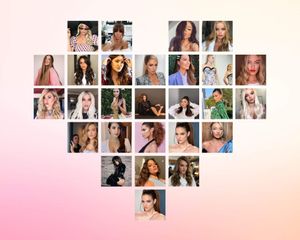Hair length chart: three simple words and an even simpler concept to avoid bad haircut surprises. It’s fairly common to have haircuts that didn’t turn out the way you expected. Don’t worry, we’ve all been there. But have you ever wondered why? It’s because there are many factors that you have to take in before you go for the chop. But once you get the hang of using a hair length chart, it’s all smooth sailing. You can say goodbye to disappointing haircuts because you can accurately convey your vision! Read on below to understand the hair length chart, hair length, and type.

Understanding hair length and type
Before we use the hair length chart, we first need to determine the length of your hair accurately. This establishes what hair type you have, making it easier to read the hair length chart. Depending on your hair type, your hair can appear shorter or longer than it actually is. Think: a ribbon would look shorter if it has been scrunched up, but longer when you pull it out straight. The same logic applies to your hair.
Straight hair
Pin-straight hair is fairly straight forward to understand – the length is exactly how you see it. Since there are no bends or curls, your hair will appear its actual length. For instance, 14 inches of hair will fall just past your shoulders.
Wavy hair
Wavy hair has slight kicks and bends, which means it will appear slightly shorter than its actual length. If you were to straighten it out, it would look like you have grown a few inches of hair. With 14 inches of length, your hair falls exactly on your shoulders.
Curly hair
Curls can be a little bit harder to decipher compared to the other two styles. This is because there can be various types of curls depending on how tight or loose they are. If your curly hair is at shoulder length, it’s actually deceivingly longer than you think. But because they’re in curls, 14 inches of length will be about an inch above your shoulders.
Reading a hair length chart
You may think that an inch or two isn’t much of a difference. However, it can be the differing factor between shoulder-length or above-shoulder length hair. As you read the explanations above, this will all depend on your hair type. After using the hair length chart, you’ll have a clearer vision of how a certain length will look on you. Now, you no longer have to guess where you want your haircut to start. You can confidently talk in inches with your hairdresser!
3 more steps before the cut

Understanding your length is crucial, but getting the perfect haircut requires three more additional steps.
Step one: Determining your face shape
Your face shape is especially important when it comes to picking a hairstyle. There are hairstyles suited to particular face shapes because it enhances or complements some of your features. If you already know your face shape, fantastic! For those who haven’t figured it out yet, keep reading on. Figuring out which profile you are – whether your face is oval, square, diamond, etc – is easy if you have distinguishing features. For instance, a sharp-angled jaw can indicate a square face shape. If your face is harder to read, there’s a trick to get it as right as possible. When this is the case, take out a tool to measure with. Rulers might work but a flexible tape measure is easier and more accurate. Measure your forehead, cheekbones, jawline, and face length. The largest of these four will be the giveaway to your face shape. For example, a greater forehead length than the cheekbones and jawline, plus a pointy chin, indicates a heart-shaped face. Editor’s note: Grab a friend to read the measurements for a more accurate reading if it gets tricky in front of a mirror. Otherwise, there are also apps that can work out your face shape for you!
Step two: Knowing your hair texture
Is your hair curly, wavy, or straight? Knowing the difference is crucial to avoid drastic haircut mistakes. Texture plays a vital role in the appearance of your hair. This means what looks good on a certain hair type may not work on you. A layered bob might look good on wavy hair, but it may look out of place on curly textures. Avoid this mistake by going for a haircut that suits your texture instead of a trendy one. If in doubt, it helps to talk your vision out with your hairstylist before committing to anything.
Step three: Testing out the length
After studying the hair length chart on inside out, you may be an expert by now. But it helps to put it into practice and test whether a particular length suits you. How, you ask? There are various ways to take a hair length for a test drive. It’s important that you do to manage your expectations. A pixie cut seems like a stunning way for an all-transforming makeover, but it may not be how you expected. This is especially true if you’ve never had that haircut or anything similar before. If you’ve got the time, try on a wig with the hairstyle you’re eyeing to see if matches your look. Alternatively, download some apps where you can virtually try on different styles and even colors. It may not be the most accurate thing, but at least you get some idea.
Thinking of going long instead?
The same rule about length applies if you want to go long with some hair extensions. As natural curly hair may appear shorter than its actual length, 20-inch curly extensions will also look a few inches shorter. So, bear this in mind before purchasing them, as extensions can be costly! When in doubt, remember to refer to the hair length chart.
The final takeaway
While the hair length chart is a useful tool, remember to refer to other factors before committing to a chop. From the lob to choppy layers, there are so many haircuts to try that it’s hard to pick one. Knowing your face shape, texture, and the right length can help narrow down your options for the most flattering haircut.





